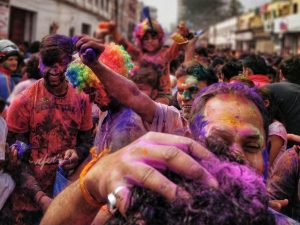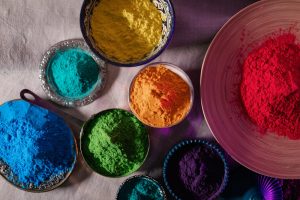- 833-265-6771
- Mon - Fri: 8:00 - 5:00 EST
(Updated March 17, 2024)
You’ve likely seen the colorful photos of smiling crowds doused in vibrant colors at a Holi festival, but you may not be totally sure about what exactly Holi is. Also known as the “Festival of Love” and “Festival of Colors,” Holi is a multidimensional celebration of spring, goodness, and camaraderie.
Holi is a joyful Hindu festival celebrated predominantly in India and Nepal – as well as by Indian communities around the world. The exact date of Holi changes from year to year because the holiday falls on the full-moon day (the Purnima) of Phalguna (usually around February or March).
Holi holds cultural and religious significance, commemorating various legends, including the story of Prahlada and Hiranyakashipu from Hindu mythology.
Holi goes beyond its religious roots to become a unifying force in communities across India and beyond. It fosters bonds between individuals of diverse backgrounds, breaking down barriers of caste, class, and age
The festival is known for its vibrant traditions, where people come together to enjoy music, dance, games, rangoli art, and the splashing of colors. People smear each other with colored powders and water, creating a mixture of hues, spreading happiness and camaraderie.
The festival promotes inclusivity, as people from all walks of life come together. Communities organize collective events, such as neighborhood gatherings, cultural performances, and charity drives, strengthening social cohesion and reinforcing a sense of belonging.
In recent years, Holi has also become a platform for social activism, with various organizations using the festival as an opportunity to raise awareness about important issues such as environmental conservation, gender equality, and inclusivity for marginalized communities.
Through art installations, workshops, and awareness campaigns, Holi becomes not only a celebration but also a catalyst for positive social change.
Holi also holds economic significance, particularly for artisans and small businesses involved in the production and sale of traditional goods like color powders, sweets, and decorations.
 Cultural Exchange and Tourism of Holi
Cultural Exchange and Tourism of HoliHoli’s exuberant events and rich cultural heritage attract tourists from all parts of the world, making it a significant event on India’s tourism calendar. Popular destinations such as Mathura, Vrindavan, and Jaipur are renowned for their extravagant Holi festivities, drawing visitors seeking an authentic cultural experience.
International tourists are increasingly drawn to India during the Holi season to witness the festival firsthand, immersing themselves in the colorful chaos and joyous atmosphere.
Many tour operators offer special Holi-themed travel packages, guided tours, cultural workshops, and homestay experiences – providing visitors with opportunities to engage more authentically with local traditions and customs.
Moreover, Holi’s global popularity has led to the emergence of Holi-inspired events and festivals in cities around the world, where multicultural communities come together to celebrate diversity and unity through the shared experience of color and music.
These events serve as platforms for cross-cultural exchange, promoting intercultural understanding and appreciation.
Overall, Holi’s worldwide impact underscores its significance as a vibrant expression of India’s cultural heritage, attracting visitors from diverse backgrounds to partake in its festive spirit and colorful traditions.
Holi is celebrated for several reasons, each rooted in mythology and tradition. One of the most prominent narratives behind the festival revolves around the legend of Prahlada and Hiranyakashipu from Hindu mythology.
According to the legend, Hiranyakashipu was a powerful and arrogant king who considered himself to be a god and demanded that everyone worship him. However, his son Prahlada was a devoted follower of Lord Vishnu, much to his father’s dismay.
Hiranyakashipu tried numerous times to coerce Prahlada into abandoning his devotion to Vishnu, but Prahlada remained steadfast in his faith. Infuriated by his son’s defiance, Hiranyakashipu subjected Prahlada to various forms of torture, including attempts to kill him.
Despite the trials and tribulations, Prahlada’s unwavering devotion to Vishnu ultimately prevailed. In one instance, Hiranyakashipu’s sister Holika, who was immune to fire, tricked Prahlada into sitting on a pyre with her.
However, divine intervention led to Holika’s demise in the fire while Prahlada emerged unscathed, symbolizing the victory of good over evil.
The night before Holi, bonfires are lit to symbolize the burning of Holika and the triumph of virtue over vice. This ritual is known as Holika Dahan.
 Why Do People Throw Color Powder At Holi?
Why Do People Throw Color Powder At Holi?Throwing color powders, or Gilal, during Holi is a cherished tradition inspired by the playful spirit of Lord Krishna and the divine love of Radha and Krishna.
It is believed that Lord Krishna, known for his playful and mischievous nature, would playfully drench his beloved Radha and other gopis with colors. Holi commemorates the playful and joyful aspects of love and relationships.
Beyond its mythological roots, this colorful tradition also serves as a social glue, bringing people together to celebrate the arrival of spring and the renewal of life. It’s an expression of unity, breaking down barriers as people of all ages and backgrounds joyfully join in the vibrant festivities.
Gulal, also known as Abeer or Abir, is a colorful powder traditionally used during the events of Holi, the Hindu festival of colors. It is made from finely ground natural ingredients such as flowers, herbs, and other botanicals.
Gulal comes in a variety of vibrant colors and is often thrown or smeared on friends and family during Holi as a joyful expression of camaraderie and festivity.
In addition to its role in Holi festivities, Gulal is also used in other cultural and religious ceremonies in India.
In the past, Gulal was crafted using natural dyes earning it the name, Herbal Gulal. This traditional concoction was cherished for its skin-friendly properties, boasting a blend of ingredients known for their nourishing benefits.
With the surge in Holi festivals and the growing fascination with colorful powders, Gulal underwent a transformation, rebranding itself as Holi powder to align with the festive spirit.
However, this evolution came with a shift away from natural ingredients, as the rising demand necessitated the adoption of synthetic colorants, which created more opportunities for mass production to keep up with the growing need.
Today holi powder, or color powder is available in a variety of colors to celebrate Holi, color runs, fundraisers, baby gender reveals, and more.